5c8f6e7667088e76cb6d014fa89ce4aa.ppt
- Количество слайдов: 48

MICROARRAY DATA ANALYSIS Mark Kon, Boston University Presentation of joint work with Dr. James Lyons-Weiler Centers for Pathology and Oncology Informatics/ University of Pittsburgh © 2005 all contents, except those reproduced from copyrighted sources and reproduced with permission and citation. All reproduced content is protected by the original copyright owners. No content may be reproduced in physical or electronic form without permission. All rights reserved.

I. Microarray Technologies


We are at the cusp of a wave… But: we can be swallowed up by data!

“Probe”: single-stranded DNA with a defined identity tethered to a solid medium “Target”: the labeled DNA or RNA

Two Main Types of Microarrays c. DNA arrays: spotted onto surface oligonucleotide arrays: created on surface

population of c. DNA microarray chip

Target labelling Cyanine dyes (Cy 3/Cy 5)

Custom c. DNA Arrays • Competitive hybridization, typically uses 2 -dye labelling (Cy 3, Cy 5) • RT-PCR to amplify targets


Disadvantages • Spot effects (identifying spot location) • Channel differences – labeling efficiencies of the c. DNA targets – Nonlinearities – Intensity-related heteroscedasticity – residuals may be input-dependent – Confounding: sometimes many other variables

From: "Data Analysis Tools for DNA microarrays" by S. Draghici, published by Chapman and Hall/CRC Press.

Proposed solutions • Adaptive normalization (intensityspecific, location-specific; locally weighted regression methods) • Dye-flip or dye-swap experiments (twice the cost!)

Dye Strategies • Custom: Typically 2 dye (but not necessarily!) • Affymetrix, Amersham: Single Dye • Agilent and Mergen: Two-dye

Oligonucleotide Arrays • Lockhart et al. 1996. Expression monitoring by hybridization to highdensity oligonucleotide arrays. Nat Biotechnol. 1996 Dec; 14(13): 1675 -80. Photolithography; 25 -mers, 16 probes per probe set e. g. , Affymetrix/Agilent

Spotted Arrays • Amersham: Code. Link™ System: Oligonucleotides • Mergen: Oligonucleotides • c. DNA spotted technology • 3 -D surface (contact for covalent attachment of probes) Next two slides; © 2003, Phillip Stafford and Peng Liu. Ch. 15, Microarray technology, comparison, statistical analysis and experimental design, IN: Microarray Methods and Applications: Nuts & Bolts (G. Hardiman, ed. , DNA Press)


Affymetrix Agilent Amersham Mergen Heart replicates Heart: Liver Human liver vs. human heart: 6963/14, 159 (49%) Human liver vs. human liver: 5129/14, 159 (36%) Human heart vs. human heart: 1204/18, 006 (6%) Human liver vs. human heart: 2595/9970 (26%) Human liver vs. human liver: 318/9778 (3%) Human heart vs. human heart: 454/9772 (5%) Human liver vs. human heart: 8572/11, 904 (72%) Human liver vs. human liver: 2811/11, 904 (24%) Human heart vs. human heart: 3515/11, 904 (30%) Human liver vs. human heart: 3904/22, 283 (18%) Human liver vs. human liver: 3875/22, 283 (17%) Human heart vs. human heart: 4026/22, 283 (18%)

Golden Rule • A technological fix to a problem is always preferred to a statistical fix.

Predictive Genomics, Biology, Medicine • Learning theory: SLT – what is it? • Parametric statistics – small number of parameters – appropriate to small amounts of data • Ex. Find mean m and standard deviation s for a normal distribution from sample data. • Nonparametric statistics – large number of parameters – appropriate to large amounts of data • Ex. Neural Network, RBF network, support vector machine

Genomics: Current interests: • New algorithms for classification of and prediction from microarray gene expression data. • Genome: about 50, 000 genes • Gene expression in cell reflects physiological factors and processes. • Discovery of patterns in gene expression data: major computational challenge. • Includes genome and genetic regulation and expression information. • Information important in diagnosing physiological factors, for example: – nature of disease, e. g. tumor – state and prognosis for a genetically inherited disease

Technology: • New, error-prone - statistical analysis must tease apart errors as well as many physiological factors present. Current methods of classification may not be as effective or accurate as they can be. • Understanding physiological correlates of gene expression (hence protein expression) promises to provide insight into conditions and diseases whose etiologies have been difficult to understand, e. g. : • autism • multiple sclerosis • muscular dystrophy • propensities for cancers and arteriosclerosis, • Alzheimer’s disease Preliminary results have been obtained in these areas.

Purpose of project: work on aspects of such an approach. • Our work involves modeling, simulation, and algorithm based approaches to classification and prediction of cell physiology from microarray information.

Major aspect: deal with numerical simulations and their complexity. • Emphasize accuracy of statistical models • Computed algorithm discovery methods will search for algorithms appropriate to models. • Subarray cocluster patterns (patterns occurring for subsets of genes and of the population). • Computational demands require the high performance resources of Center for Computational Science at BU • Statistical models of microarray experiments: Gene Expression Data Simulator (GEDS) at University of Pittsburgh

Numerical Simulations and their complexity • Error of classification, prediction algorithms calculated with Monte Carlo simulations on GEDS • Algorithms for discovery of subarray coclusters, testing sparse data for underlying distribution families, extending regressionattraction algorithm. • Will also develop local numerical algorithms for "customized" predictions for individuals from microarrays.

Collaboration: • Boston University (Mathematics and Statistics, Microarray Resource at the Medical School, and Center for Computational Science; Bioinformatics Program • University of Massachusetts Lowell (Mathematics and Statistics) • University of Pittsburgh Medical School (Medical School microarray core laboratory; UPCI Cancer Biomarkers Laboratory, Pitt. Array core laboratory) • Ben Gurion University in Israel (BGU Human Molecular Genetics Lab, Computer Science Department’s Bioinformatics Program) •

Goals: answer questions • • • Can computer implementations of microarray models be used to improve them? Can model and parameter determination be accomplished computationally? Can statistical algorithms to solve the models be tested, developed, and improved on such models?

Goal: answer questions • • Can statistical methods improve the yield of microarray information for small numbers of subjects? Can sub-patterns (patterns in subsets of the genome and population) in microarray data be verified, discovered, and used? What are maximal levels of information which can be obtained from gene expression information? Can we obtain probabilities that a queried patient belongs to a given trained group together with confidence bounds? What can simulation of the genetic expression profile of cancer cells reveal about potential responses to therapies?

Statistical methods work better when they incorporate biological models as a priori information. • Strategy: divide translation of physiological models into algorithms into three parts: • biological modeling • statistical modeling • algorithm development • From biology to statistical modeling: two way process • biology statistical model simulated biological data (with scalable microarray simulation).

Algorithm simulation After statistical model is decided on: find algorithms which solve model – given complexity of good algorithms, we will use Monte Carlo to gauge efficiency via microarray simulator.

Further study: Automated algorithm development via search methods within algorithm classes

Co-regulation of genes: • Many new methods (e. g. graph-theoretic methods of cataloguing coregulation from published literature) • Will study automated methods of incrementing statistical models with information, and incorporating models into simulator. Simulator will allow testing models, via comparisons of simulator and biological data. Such objective tests of models do not presently exist.

More specific aims: • 1: Develop tests of statistical models of microarrays through comparisons with computational simulations, and develop new models and methodologies on this basis, and discover and modify algorithms for these models. • 2: Develop optimal robust classification algorithms for microarrays based on models, with probability estimates of classification membership and confidence bounds, and develop statistical methods for reducing patient sample sizes necessary.

More specific aims • 3: Test classification algorithms and improve statistical properties through Monte Carlo simulation of accuracies, and use (low and eventually high dimensional) search techniques to find better algorithms. • 4: Study search algorithms for discovering subarrays containing patterns not visible in full arrays. • 5: Test and apply these methodologies to existing cancer databases for differentiating cancer gene expression information. • 6: Apply these methods to develop software for practitioners using microarrays.

Outcomes: new tools for differentiating microarray clusters will be available • • • Information based on clustering of interacting genes and sub-populations affected by them will be obtainable from microarray analysis. More accurate statistical models of microarrays will be implementable and testable using microarray simulator under development at the University of Pittsburgh. Classification algorithms with tunable parameters (appropriate to different biological models) will be available, with class probability estmates and confidence bounds.

Outcomes: new tools for differentiating microarray clusters will be available • • Applications of the above techniques to the development of diagnostic tools for differentiating cancer gene expression information will be developed Open source software implementing this work will be available.
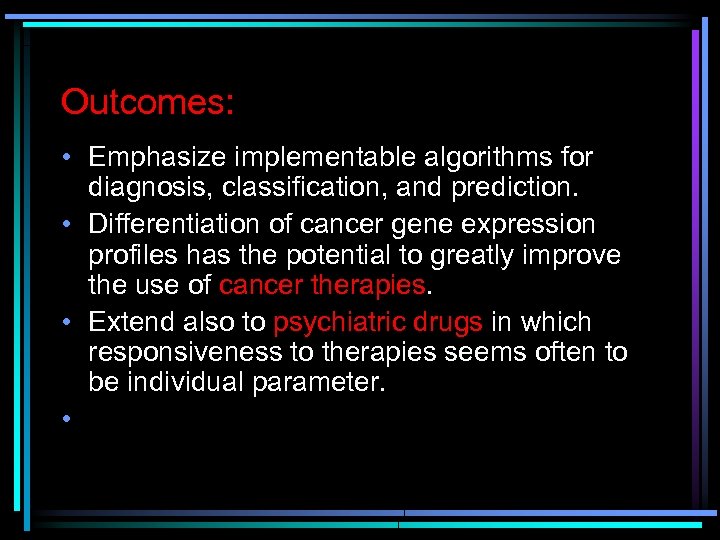
Outcomes: • Emphasize implementable algorithms for diagnosis, classification, and prediction. • Differentiation of cancer gene expression profiles has the potential to greatly improve the use of cancer therapies. • Extend also to psychiatric drugs in which responsiveness to therapies seems often to be individual parameter. •

Approach: separation of model from algorithm. • Modeling: biological problem • Once model is found, finding algorithm which decides which class (e. g. , metastatic or non-metastatic tumors) microarray comes from becomes a purely statistical and computational; notions of complexity and optimality then become appropriate and welldefined. • Correspondingly, errors from classification algorithms can be broken down into two parts: model error and algorithmic error.
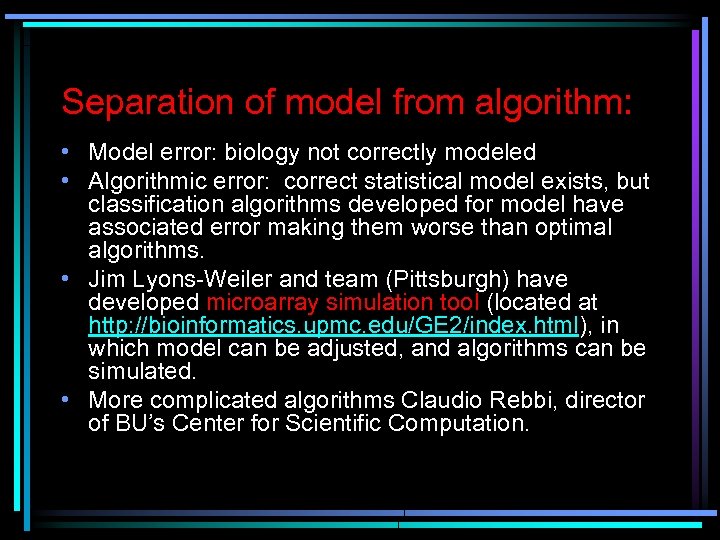
Separation of model from algorithm: • Model error: biology not correctly modeled • Algorithmic error: correct statistical model exists, but classification algorithms developed for model have associated error making them worse than optimal algorithms. • Jim Lyons-Weiler and team (Pittsburgh) have developed microarray simulation tool (located at http: //bioinformatics. upmc. edu/GE 2/index. html), in which model can be adjusted, and algorithms can be simulated. • More complicated algorithms Claudio Rebbi, director of BU’s Center for Scientific Computation.

Gene Expression Data Simulator: • Fig. 1. A Case vs. Control Pattern of Inheritance Model in Detail. Between group correlations specified by Dr. AB and within group correlations are specified by Dr. A for group A and Dr. B for group B.

Outcome of jittering process
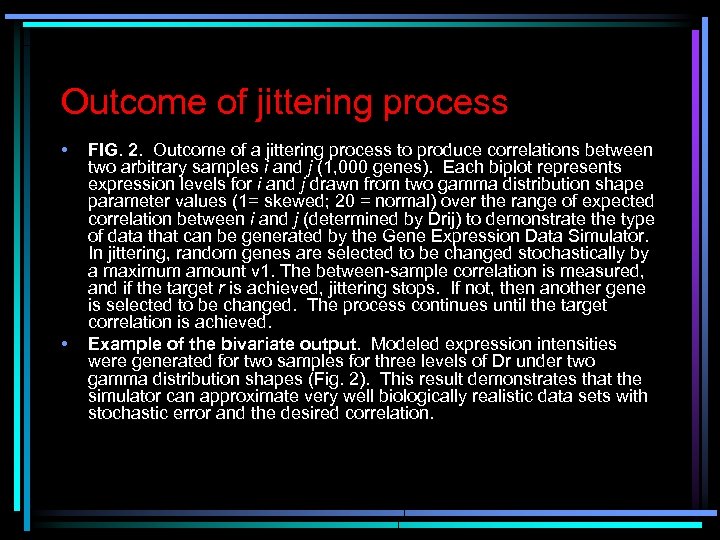
Outcome of jittering process • • FIG. 2. Outcome of a jittering process to produce correlations between two arbitrary samples i and j (1, 000 genes). Each biplot represents expression levels for i and j drawn from two gamma distribution shape parameter values (1= skewed; 20 = normal) over the range of expected correlation between i and j (determined by Drij) to demonstrate the type of data that can be generated by the Gene Expression Data Simulator. In jittering, random genes are selected to be changed stochastically by a maximum amount v 1. The between-sample correlation is measured, and if the target r is achieved, jittering stops. If not, then another gene is selected to be changed. The process continues until the target correlation is achieved. Example of the bivariate output. Modeled expression intensities were generated for two samples for three levels of Dr under two gamma distribution shapes (Fig. 2). This result demonstrates that the simulator can approximate very well biologically realistic data sets with stochastic error and the desired correlation.
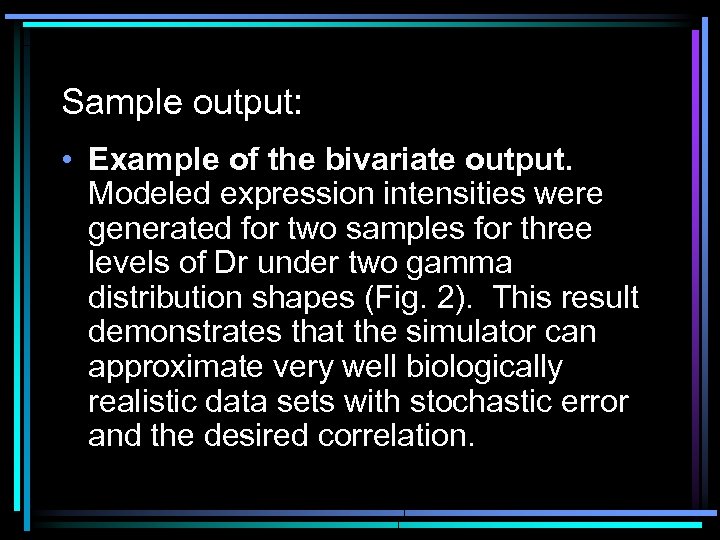
Sample output: • Example of the bivariate output. Modeled expression intensities were generated for two samples for three levels of Dr under two gamma distribution shapes (Fig. 2). This result demonstrates that the simulator can approximate very well biologically realistic data sets with stochastic error and the desired correlation.
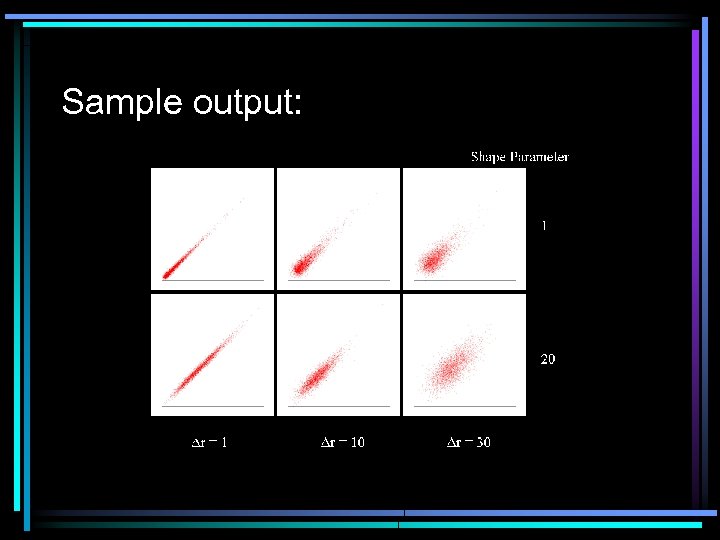
Sample output:
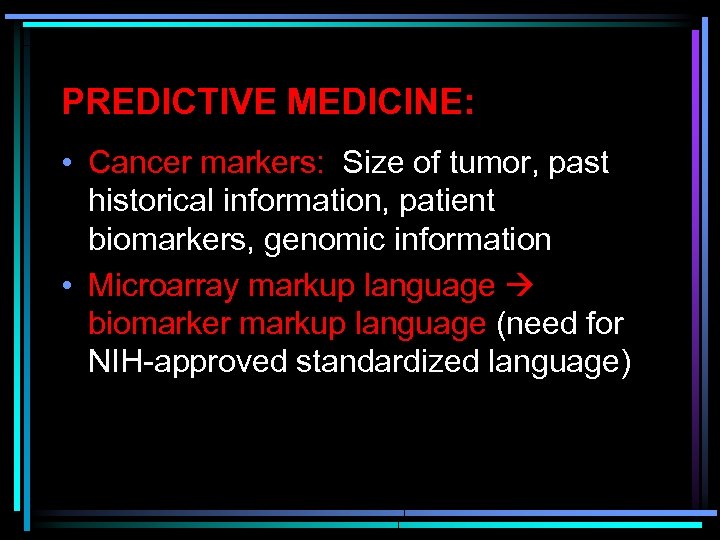
PREDICTIVE MEDICINE: • Cancer markers: Size of tumor, past historical information, patient biomarkers, genomic information • Microarray markup language biomarker markup language (need for NIH-approved standardized language)
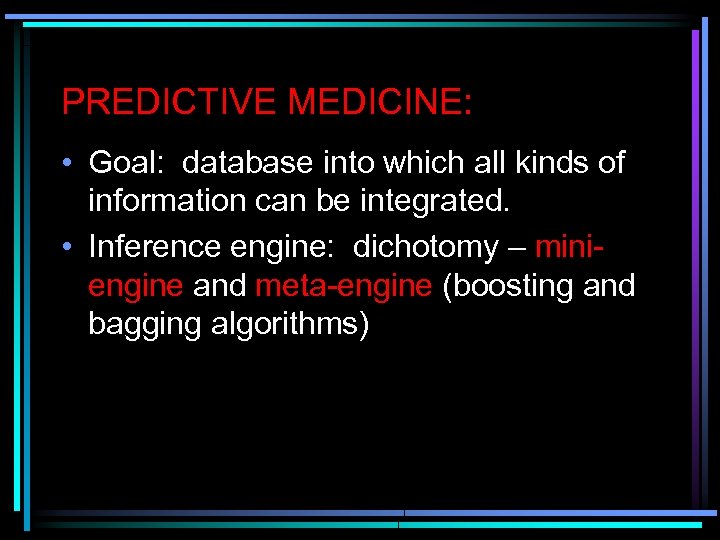
PREDICTIVE MEDICINE: • Goal: database into which all kinds of information can be integrated. • Inference engine: dichotomy – miniengine and meta-engine (boosting and bagging algorithms)
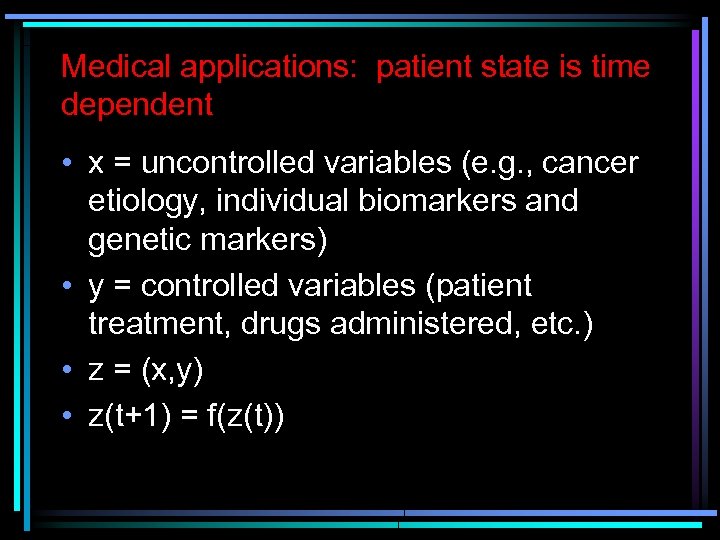
Medical applications: patient state is time dependent • x = uncontrolled variables (e. g. , cancer etiology, individual biomarkers and genetic markers) • y = controlled variables (patient treatment, drugs administered, etc. ) • z = (x, y) • z(t+1) = f(z(t))

Other connections: • Learning: Discover the function f(t) from databases of examples • Control theory: how to adjust y(t) (controlled variables) so that disease history z(t) progresses as well as possible? • Financial mathematics – algorithms there also apply to control theory aspects here • Stochastic differential equations • dx/dt = B’(t) + b(x) • C. Rebbi: simulations (Matlab nlinfit program suffices) – psychiatric data, simulated cancer data
5c8f6e7667088e76cb6d014fa89ce4aa.ppt